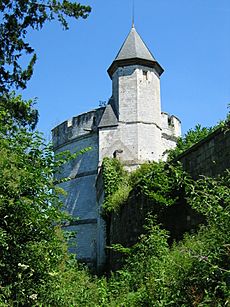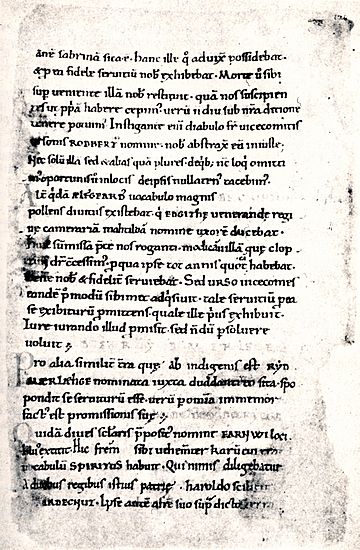Urse d'Abetot facts for kids
Quick facts for kids
Urse d'Abetot
|
|
|---|---|
| Sheriff of Worcestershire | |
| In office c. 1069–1108 |
|
| Preceded by | Cyneweard of Laughern |
| Succeeded by | Roger d'Abetot |
| Royal constable | |
| In office after 1087 – 1108 |
|
| Personal details | |
| Born | c. 1040 Normandy, France |
| Died | Summer of 1108 |
| Spouse | Alice |
| Children | Roger d'Abetot, daughter (perhaps named Emmeline) |
Urse d'Abetot (born around 1040 – died 1108) was a Norman nobleman. He came to England with King William I after the Norman Conquest of England in 1066. Urse became an important royal official, serving as the Sheriff of Worcestershire. He also worked for William I's sons, Kings William II and Henry I.
Urse was from a village in Normandy, France, called Abetot. He became sheriff around 1069. He built the first Worcester Castle in Worcester. This castle was built on land that used to be a church cemetery. Because of this, the Archbishop of York famously put a curse on Urse! Urse helped stop a rebellion against King William I in 1075. He also had many disagreements with the Church in his area about who had power. Urse was known for wanting to gain more land and wealth. After his death, his son became sheriff but was later sent away from England. Urse's daughter became an ancestor of the powerful Beauchamp family.
Contents
England After the Norman Conquest
How William I Became King
On January 5, 1066, Edward the Confessor, the King of England, died. He had no children, which led to a big argument over who should be the next king. Some people said Edward had chosen his brother-in-law, Harold Godwinson, as his heir. Others claimed Edward had promised the throne to his cousin, William, the Duke of Normandy.
Harold Godwinson was a very powerful English noble. He quickly became king on January 6. William, however, gathered his army and a fleet of ships. He invaded England in October 1066. William defeated and killed Harold at the Battle of Hastings on October 14, 1066. William was crowned king on Christmas Day at Westminster Abbey. He became known as William the Conqueror.
Changes in England
After becoming king, William spent several years making sure he had full control over England. He put down many rebellions, especially in the north and west. At first, only English nobles who fought against William lost their lands. These lands were then given to Normans and others who had helped William's invasion.
Later rebellions led to even more English land being taken away. By 1086, when William ordered the creation of the Domesday Book, most of the English nobles had been replaced. Their lands were now owned by Norman and other European nobles.
Urse's Family and Early Life
Urse d'Abetot came from a family that was not very famous. He became well-known because of his skills as a soldier. He was probably born around 1040, but the exact date is not known. Urse was from a village called St Jean d'Abbetot in Normandy. His family owned land there, and he also rented land from the powerful lords of Tancarville.
Urse had a brother named Robert Despenser. Robert also became an important royal official. Some historians think "Urse" might have been a nickname for Urse d'Abetot. It could have been given because of his strong and determined personality. His last name, d'Abetot, comes from his home village in Normandy. His brother's last name, Despenser, came from his job as a "dispenser" in the king's household.
Ralph, the Lord of Tancarville, was Urse's landlord in Normandy. Ralph fought at the Battle of Hastings. However, there is no proof that Urse himself was there. One historian described Urse as "a man of no importance who made his way as a soldier."
Urse's Service to William I
Becoming Sheriff of Worcester
Urse arrived in England after the Battle of Hastings. He was appointed Sheriff of Worcestershire around 1069. This was part of King William's plan to replace English officials with Normans. As sheriff, Urse had many important jobs. He collected taxes for the king and sent them to the treasury. He could also gather armies if there was a rebellion or an invasion.
The sheriff was in charge of the shire court, which was like a local court. Sheriffs were also responsible for their county's yearly payments to the king. During the time of William the Conqueror and his sons, the sheriff was a very powerful person. They controlled the local courts and had a big say in who served on juries. When Edwin, Earl of Mercia, died in 1071, Urse gained even more power in Worcestershire.
Building Worcester Castle
Urse also oversaw the building of a new castle in the town of Worcester. Today, nothing remains of this original castle. Worcester Castle was built by 1069. Its outer walls were built on land that had been the cemetery for the monks of Worcester Cathedral. The castle's main mound, called a motte, looked over the river.
Urse controlled the castle after it was built. However, by 1088, he had lost control of it to the bishops of Worcester.
Stopping a Rebellion
In 1075, three powerful earls rebelled against King William I. They asked for help from the King of Denmark. One of these rebels was Roger de Breteuil, the Earl of Hereford. His lands were next to Urse's.
Urse, along with Bishop Wulfstan of Worcester and other nobles, stopped de Breteuil. They prevented him from crossing the River Severn. Urse's actions kept the rebels from taking control of the Severn Valley. This also stopped them from joining up with other English rebels. De Breteuil was caught, put on trial, and imprisoned for life. This increased the power of Urse and his allies.
Disputes with Church Leaders
Urse often argued with church leaders, especially Bishop Wulfstan. These arguments were about the sheriff's power over church lands. By 1086, Urse's power as sheriff was limited in Oswaldslaw. This was an area of Worcestershire controlled by the bishops of Worcester. This area was considered "immune" from royal officials' actions. Urse complained that this reduced his income, but Bishop Wulfstan won the dispute.
Urse also took lands from the Worcester diocese. These lands had been leased by a relative of an earlier bishop. After Urse took them, he kept them for himself instead of returning them to the bishop. A monk named Hemming wrote about these lands that Urse took.
The chronicler William of Malmesbury wrote about Urse building his castle. He said it was built on the cemetery of Worcester Cathedral. Ealdred, the Archbishop of York, was very angry. He famously cursed Urse, saying, "You are called Urse. May you have God's curse!" Ealdred had been the Bishop of Worcester before becoming archbishop.
Another writer, Gerald of Wales, said Bishop Wulfstan himself gave the curse. He said Wulfstan cursed Urse after Urse tried to have him removed as bishop. Gerald wrote that Wulfstan then performed a miracle at Edward the Confessor's tomb. This miracle was so amazing that King William confirmed Wulfstan as bishop. Even though Urse did not succeed in removing Wulfstan, it shows they were powerful rivals in Worcestershire.
The Archbishop's curse did not seem to affect Urse's career or the castle. Other writers said Urse stole land from monasteries. Urse gained a reputation for being greedy, especially when it came to church lands.
Urse's Lands in Domesday Book
The Domesday Book of 1086 recorded all the landholders in England. It shows that most of Urse's lands were in Worcestershire. He also owned land in Warwickshire, Herefordshire, and Gloucestershire. Some of his lands he held directly from the king. Other lands he held as a "sub-tenant," meaning he rented them from other powerful nobles.
The Domesday Book also shows how much money Urse was responsible for as sheriff. He had to collect £128 and 4 shillings from Worcestershire for the king. He also had to collect money from the town of Worcester and from the shire and hundred courts. Urse had to pay the queen £5 plus an extra £1 for a "sumpter horse" (a horse for carrying goods). Urse had to make sure all these payments were made, even if there was a shortfall.
The Domesday Book makes it clear that Urse was the most powerful layman in Worcester. Only the Bishop of Worcester could challenge his power in the county. This power struggle continued even after Urse's death.
Service to William II and Henry I
After King William I died, Urse continued to serve his sons, Kings William II and Henry I. William I gave his oldest son, Robert Curthose, the duchy of Normandy. His second son, William Rufus, became King of England. Henry, the youngest son, received money.
In 1088, Urse was present at the trial of the Bishop of Durham. During William I's reign, Urse mainly worked as a local official. But under William II, Urse started to play a bigger role in the whole kingdom. He became a "constable" in the king's household for both William II and Henry I. Under William II, he also became a "marshal."
Urse helped William II's main minister, Ranulf Flambard. He often served as a royal judge. Some historians believe Urse was one of the first "barons of the Exchequer." This was a group of important officials who managed the king's money. When the king was away from England, he sent orders to Urse and other officials. These orders told them to make sure the king's decisions were followed.
Urse's landholdings grew under William II. He inherited some lands from his brother, Robert Despenser, who died around 1097. Urse also traded some of his brother's lands for others closer to his base in Worcestershire. Urse gained an estate called Salwarpe in Worcestershire, which he passed on to his family.
King William II died in a hunting accident in 1100. His younger brother Henry quickly became king. When Robert Curthose, Henry's older brother, invaded England in 1101, Urse supported Henry. Urse continued to be an important official for Henry I. Henry even granted Urse some lands directly from the king, which Urse had previously held from other nobles.
Around 1108, King Henry sent a message to Urse and the Bishop of Worcester. The king ordered the sheriff not to call the local courts at unusual times or places. This suggests that Urse might have been calling courts at odd times and then fining people who did not show up. The king wanted this practice to stop.
Urse's Death and Legacy
Urse d'Abetot died in the summer of 1108. Not much is known about his wife, Alice. Urse's son, Roger d'Abetot, became sheriff after him. However, Roger was sent away from England around 1110 and lost the office of sheriff. Urse also had a daughter, probably named Emmeline. She married Walter de Beauchamp. Walter inherited Urse's lands after Roger was exiled.
Urse was known for taking money and goods from people. During William II's reign, he was considered almost as greedy as the king's minister, Ranulf Flambard. The first mention of his actions is in Hemming's Cartulary. Later writers like William of Malmesbury and Gerald of Wales also wrote about his greed and the Archbishop's curse. The Domesday Book also noted that he treated the people of Sodbury so badly that they could not pay their usual rents.
He even forced the monks of Worcester Cathedral to lease him two of their estates. Urse was a new kind of royal official. He welcomed the king's power because it helped him gain more power and wealth for himself.
Through his daughter, Urse is an ancestor of the Beauchamp family. This family later became the Earls of Warwick. It is likely that the Beauchamp family's symbol, a bear, comes from their connection to Urse.




